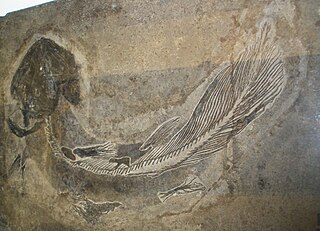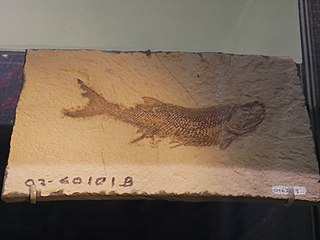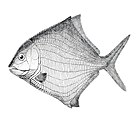
Actinopterygii, members of which are known as ray-finned fish or actinopterygians, is a class of bony fish that comprise over 50% of living vertebrate species. They are so called because of their lightly built fins made of webbings of skin supported by radially extended thin bony spines called lepidotrichia, as opposed to the bulkier, fleshy lobed fins of the sister class Sarcopterygii. Resembling folding fans, the actinopterygian fins can easily change shape and wetted area, providing superior thrust-to-weight ratios per movement compared to sarcopterygian and chondrichthyian fins. The fin rays attach directly to the proximal or basal skeletal elements, the radials, which represent the articulation between these fins and the internal skeleton.

Dapedium is an extinct genus of primitive marine neopterygian ray-finned fish. The first-described finding was an example of D. politum, found in the Lower Lias of Lyme Regis, on the Jurassic Coast of England. Dapedium lived in the Late Triassic to the Middle Jurassic period, from the late Norian to the early Aalenian.

Saurichthys is an extinct genus of predatory ray-finned fish from the Triassic Period. It is the type genus of the family Saurichthyidae, and the most speciose and longest lasting genus in the family. This family also includes the Permian Eosaurichthys (China) and the Jurassic Saurorhynchus from Europe and North America, though it may be more appropriate to treat these as subgenera of Saurichthys, due to the genus Saurichthys otherwise being paraphyletic.

Coelacanthus is a genus of extinct marine coelacanths known from the late Permian period. It was the first genus of coelacanths described, about a century before the discovery of the extant coelacanth Latimeria. The order Coelacanthiformes is named after it.

The Palaeonisciformes, commonly known as "palaeoniscoids" are an extinct grouping of primitive ray-finned fish (Actinopterygii), spanning from the Silurian/Devonian to the Cretaceous. They are generally considered paraphyletic, but their exact relationships to living ray-finned fish are uncertain. While some and perhaps most palaeoniscoids likely belong to the stem-group of Actinopteryii, it has been suggested that some may belong to the crown group, with some of these possibly related to Cladistia and/or Chondrostei. Many palaeoniscoids share a conservative body shape and a similar arrangement of skull bones.

Birgeria is a genus of carnivorous marine ray-finned fish from the Triassic period. Birgeria had a global distribution, with fossil known from Madagascar, Spitsbergen, Germany, Switzerland, Italy, Slovenia, China, Russia, Canada and Nevada, United States. The oldest fossils are from Griesbachian aged beds of the Wordie Creek Formation of East Greenland. Birgeria existed throughout the entire Triassic period, from the very beginning just after the Permian-Triassic mass extinction, up to the very end with its extinction during the Triassic-Jurassic mass extinction.

Amblypterus is an extinct genus of freshwater ray-finned fish that lived during the Gzhelian and Cisuralian epoch in what is now Europe and possibly India and Argentina. Potential indeterminate records stretch as far back as the early Carboniferous.

Hybodontiformes, commonly called hybodonts, are an extinct group of shark-like cartilaginous fish (chondrichthyans) which existed from the late Devonian to the Late Cretaceous. Hybodonts share a close common ancestry with modern sharks and rays (Neoselachii) as part of the clade Euselachii. They are distinguished from other chondrichthyans by their distinctive fin spines and cephalic spines present on the heads of males. An ecologically diverse group, they were abundant in marine and freshwater environments during the late Paleozoic and early Mesozoic, but were rare in open marine environments by the end of the Jurassic, having been largely replaced by modern sharks, though they were still common in freshwater and marginal marine habitats. They survived until the end of the Cretaceous, before going extinct.
Daedalichthys is an extinct genus of prehistoric freshwater ray-finned fish that lived during the Early Triassic epoch. It contains a single species, D. formosa from the Olenekian-aged Cynognathus Assemblage Zone of South Africa. It was previously classified in Dictyopyge.
Helichthys is an extinct genus of prehistoric bony fish that lived during the Early Triassic epoch in what is now South Africa.

Cornuboniscus is an extinct genus of prehistoric freshwater ray-finned fish that lived during the Pennsylvanian epoch (Carboniferous), and the only member of the family Cornuboniscidae. It contains a single species, C. budensis from the Bashkirian/lower Westphalian age of what is now Cornwall, England. The genus Cornubonisus was named after the island of Cornubian, and the species name refers to the coastal town of Bude in Cornwall. The type specimen is held in the town's Castle Heritage Centre.

Cyranorhis is an extinct genus of prehistoric marine ray-finned fish that lived during the Serpukhovian age of the Carboniferous period. One species is known, C. bergeraci in the Bear Gulch Limestone what is now Montana, United States. It is named after French novelist Cyrano de Bergerac.
Psilichthys is an extinct genus of prehistoric bony fish from Eumeralla Formation, the Lower Cretaceous epoch of what is now Victoria, Australia, known from single species P. selwyni. This is the first Mesozoic fossil vertebrate named from Victoria.

Palaeoniscidae is an extinct family of "palaeoniscoid" ray-finned fishes (Actinopterygii). The family includes the genus Palaeoniscum and potentially other Palaeozoic and Mesozoic early actinopterygian genera. The name is derived from the Ancient Greek words παλαιός and ὀνίσκος.

Ptycholepiformes are an extinct order of prehistoric ray-finned fish that existed during the Triassic period and the Early Jurassic epoch. The order includes the genera Acrorhabdus, Ardoreosomus, Boreosomus, Chungkingichthys, Ptycholepis, and Yuchoulepis. Although several families have been proposed, some studies place all these genera in the same family, Ptycholepididae.

Bobasatraniiformes is an extinct order of durophagous ray-finned fish that existed from the late Permian to the Middle Triassic in both marine and freshwater environments. The order includes two families: Bobasatraniidae, with the genera Bobasatrania, Ebenaqua, and Ecrinesomus, and Dorypteridae, comprising only the genus Dorypterus (monotypy). Bobasatraniiformes had a somewhat global distribution; fossils are found in Africa (Madagascar), Asia (Pakistan), Australia, Europe, and North America.
Brian George Gardiner PPLS was a British palaeontologist and zoologist, specialising in the study of fossil fish (palaeoichthyology).
The Besano Formation is a geological formation in the southern Alps of northwestern Italy and southern Switzerland. This formation, a thin but fossiliferous succession of dolomite and black shale, is famous for its preservation of Middle Triassic (Anisian–Ladinian) marine life including fish and aquatic reptiles. It is exposed in the Monte San Giorgio and Besano area. It is among the formations responsible for the area being designated as a UNESCO World Heritage Site. In Switzerland, it is also known as the Grenzbitumenzone. The Anisian-Ladinian boundary lies in the upper part of the Besano Formation.
Eochondrosteus is a genus of extinct actinopterygian, comprising one species, E. sinensis (monotypy) from the Early Triassic strata in Gansu Province, China. It is suggested to be the most basal acipenseriform. It was originally described in 2005, and then redescribed in 2020 in Chinese. Other authors have considered the placement of Eochondrosteus within the Acipenseriformes as tentative.
Brazilichthys is an extinct genus of prehistoric freshwater ray-finned fish that lived during the Cisuralian epoch in what is now Maranhão, Brazil. The type and only species, B. macrognathus, is known from a single partially complete skull, which was recovered from the Pedra de Fogo Formation near Pastos Bons, Maranhão, Brazil.





















